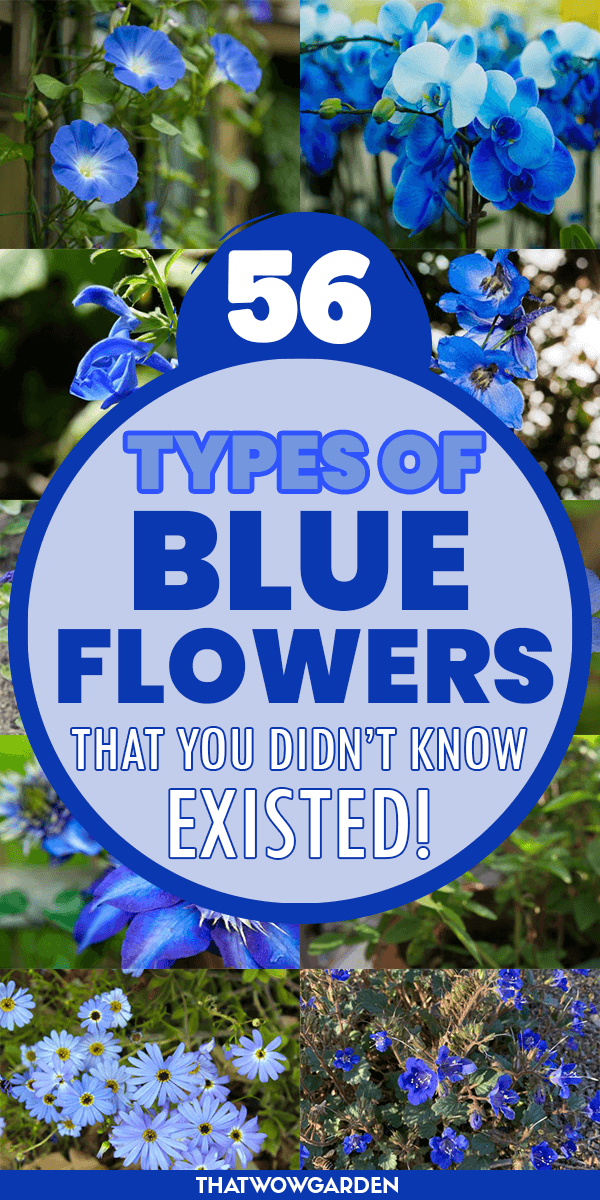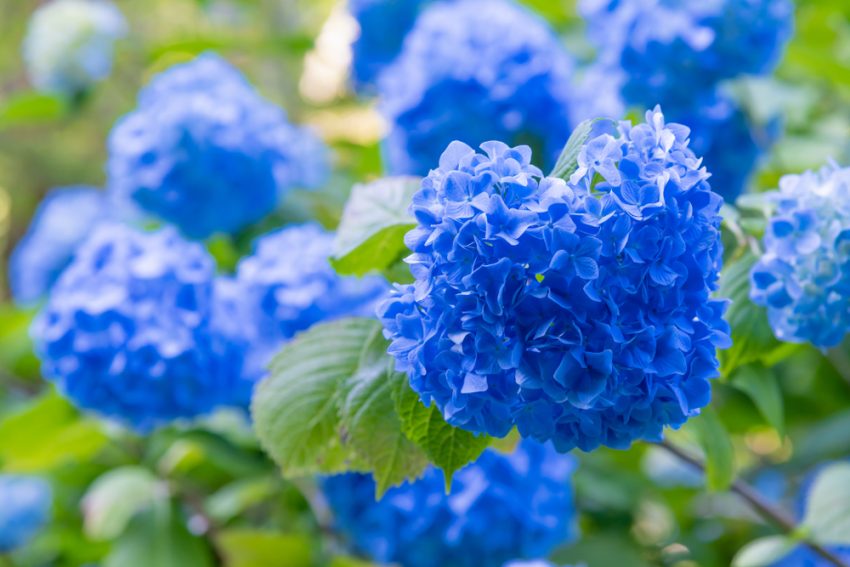The blue color is undoubtedly the most impeccable color to ever exist. You ain’t human if you don’t love royalty and fidelity of the magnanimous blue color. Incorporate the grace of this color into your garden and create a sight to swoon away the onlookers.
Different shades of blue color depict different emotions and feelings. For instance, it symbolizes gloomy nature on one hand and tranquility on the other. The color is more expressive than most humans ( lol 😛 ).
Surprisingly, blue flowers rarely exist in nature as there’s no blue-colored pigment present in the plants. Scientifically, for a substance to seem blue, it’s essential that it absorbs red photons of the visible light. An evolved class of plant pigments – the anthocyanins, under suitable chemical reactions, naturally absorb red light but the phenomenon occurs seldomly ( quite a lot of chemistry 😛 ). However, scientists and gardeners breed similar shades through artificial methods.
Did you know that Rudyard Kipling, a celebrated British poet, has even mentioned the unattainability of a blue flower in one of his prominent poems? More on that later!
Let’s look at 56 types of blue flowers that are competent enough to inculcate prettiness in your garden and eventually in your life!
56 Types Of Blue Flowers
1. Grape Hyacinth
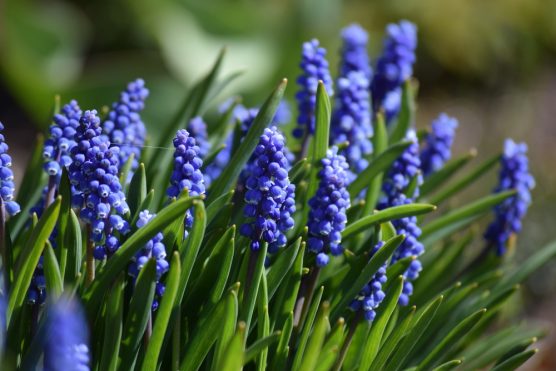
Grape Hyacinth ( Muscari armeniacum ) is one of the most recognizable blue flowers owing to its globular bulb-shaped flowers. These flowers grow in clusters making the plant look loaded.
Infusing this royal blue color into your garden is pretty low maintenance. It requires well-drained soil with medium moisture and complete exposure to the sun. Water them in their blooming season, i.e., spring, and allow them to dry between watering in the consecutive seasons.
Keep your children and pets away from this flower as it can be slightly toxic to them.
2. Birdbill Dayflower
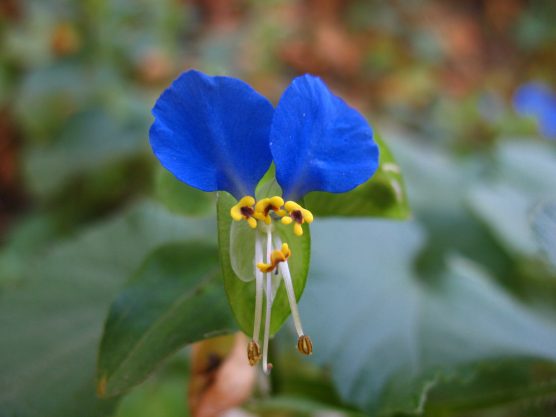
Commelina dianthifolia, commonly known as Birdbill Dayflower, is a charming blue flower that derives its name from its tendency to bloom around dawn and lose freshness by the mid-day.
Birdbill Dayflower is not only ornamental but is also functional. One could use this plant as an energy booster for weakened tuberculosis patients.
Locate this plant in moist and rocky soil under partial sun. Water the plant infrequently to prevent the rotting process.
3. Siberian Bugloss
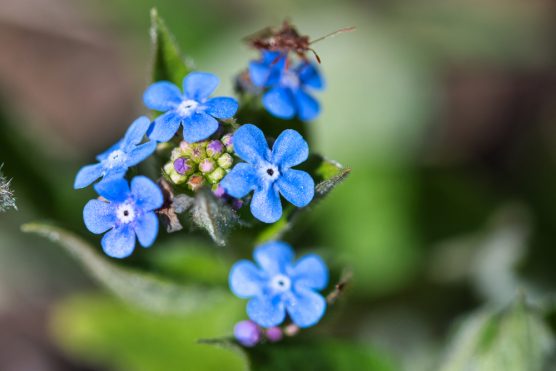
Siberian Bugloss is scientifically known as Brunnera macrophylla. This plant has a flower consisting of 5 equally-sized petals. The flower isn’t exactly blue but a hue of violet which is pretty close to blue shade.
It has deciduous variegated foliage that requires a shady spot and rich moist soil to thrive the best. You can skip the watering now and then once the plant is established, however, water it frequently in the beginning.
Also, you can grow this tiny flower in the container during the winter season.
4. Perennial Geraniums
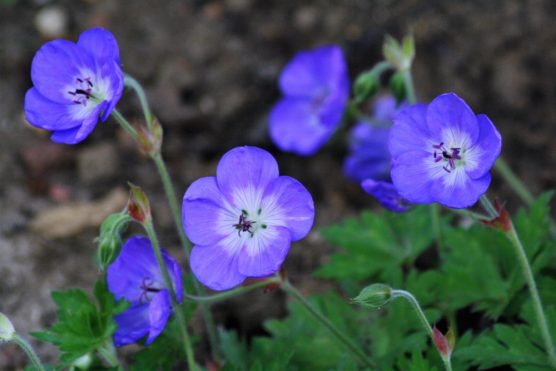
Scientifically known as Geranium ‘Johnson’s Blue’ and commonly known as cranesbill, perennial geraniums are lavender-blue flowers with rich green-colored foliage. If you want to invite butterflies or bees to your garden, cranesbill is a great option.
The flower blooms incessantly from late spring to fall due to which they make the perfect edge flowers. The plant is deer-resistant and prefers partial sun to full shade. Select a well-drained sandy and rich in compost soil for its best growth. Water it just to keep the soil moist.
5. Gentian
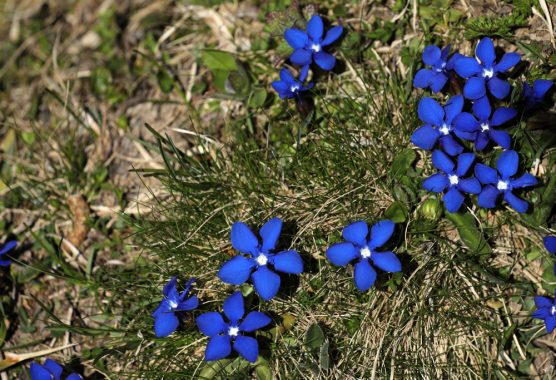
Gentian ( Gentiana ) is highly welcoming to the pollinators like bees, flies, birds, and whatnot. The shade of this plant depends on the environmental conditions of the particular area.
In the Northern hemisphere, it blooms blue-colored flowers. It’s interesting to note that a certain type of Gentian doesn’t fully bloom until coerced by the right pollinator. Amazing, right? The flower is also known to be a remedy for snakebites, digestive problems, hypertension, malaria, and even cancer.
6. Russian Sage
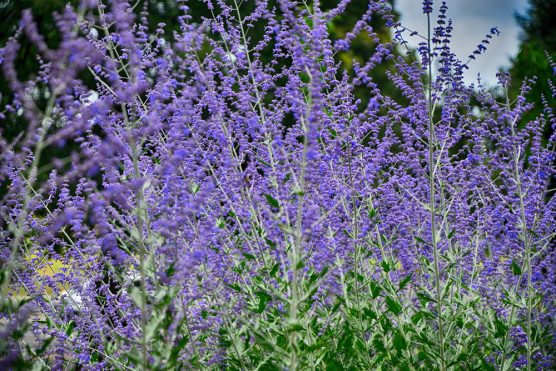
Russian sage ( Perovskia atriplicifolia, you don’t have to enunciate it 😛 ) is a fragrant indigo-blue shaded flower that attracts butterflies and hummingbirds big-time! Locate a spot with well-drained soil average soil and grow this plant under full sun.
Plant Russian Sage deep into the soil to maintain an extensive root system. Water it adequately till it’s still new, it becomes drought-resistant once established. Alongside inviting pollinators to your garden, it would also shoo away the invaders like deers and rabbits.
7. Hepatica Nobilis
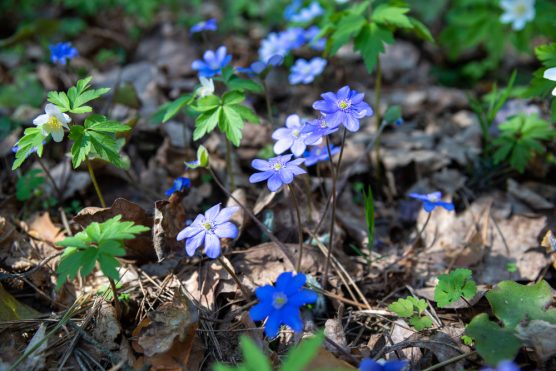
Anemone hepatica, commonly known as Hepatica Nobilis or Liverwort is an ornamental plant that you can profusely use as beds, borders, and underplanting shrubs. It has attractive violet-blue colored petals and white-colored stamens visible on its surface.
To grow this plant in your garden, you need humus-rich that’s well-drained, moist, and slightly alkaline in nature. Besides, the plant is tolerant of negligence, once established and it thrives well in partial to full shade.
Do you know that this plant has been felicitated with the Award of Garden Merit by the British Royal Horticultural Society? Well, now you do!
8. Columbine
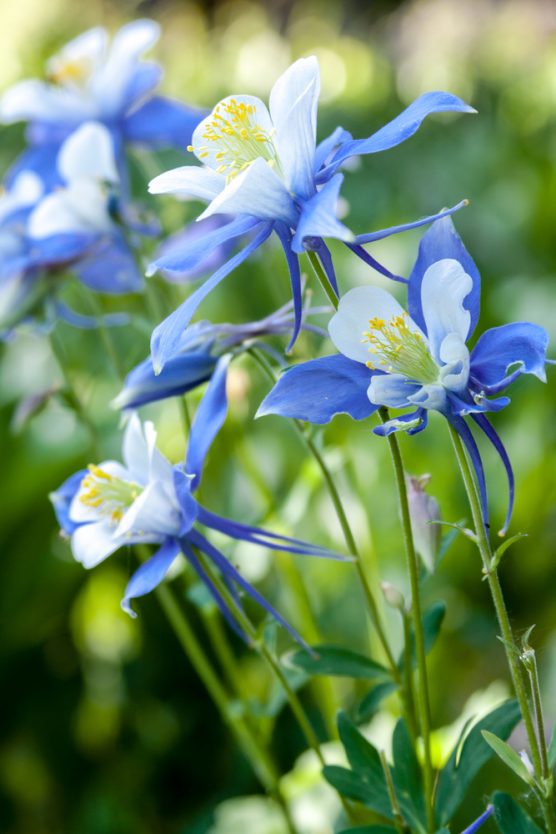
Columbine or Aquilegia isn’t particularly a blue-colored flowering plant, rather it’s available in a plethora of shades. The actual colors of its leaves are a deep fusion of blue and violet with a tiny white color flower protruding from its center.
Although this plant loves full sun, it thrives the best in partial shade during the summer season. Choose a well-drained moist soil and water the plant weekly, once established. Also, feed it water-soluble fertilizer for high-quality foliage and flowers.
Remember that if you’re growing this plant from seeds, it won’t bloom for 2 years.
9. Lithodora
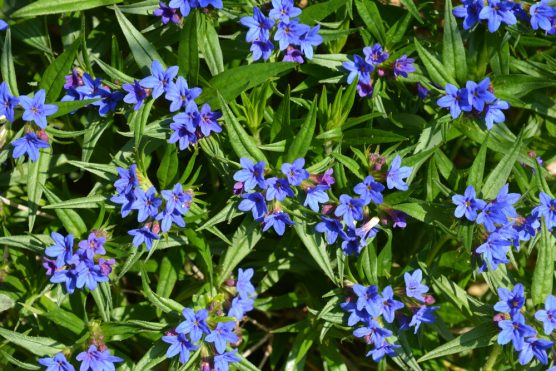
If you’re looking for a blue shade flower to plant in your rocky garden, Lithodora ( Lithodora Diffusa ) is a potential candidate for you. The plant is commonly known as ‘Grace Ward’. The shoot of this plant includes star-shaped deep blue flowers.
It’s a sun-loving plant, with afternoon shade in the summer season, that can survive well in any average quality soil ( except for heavy clay ). The water requirements are also quite low, just don’t let it become dry between the watering. And, it’s also a recipient of the Award of Garden Merit by the Royal Horticultural Society!
10. Virginia Bluebells
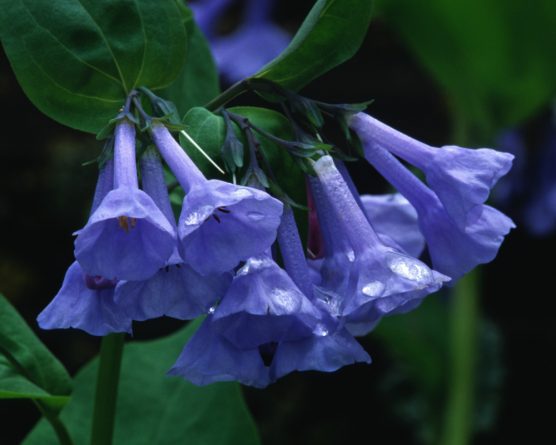
Mertensia virginica or Virginia Bluebells is an interesting flower to include in your garden. These flowers are downright ornamental and you can easily identify them through the clusters of blue or violet bells. The plant is pretty invasive and would require a lot of space to grow.
Grow Virginia Bluebells in partial shade to get the best yield. Water is enough to keep the soil moist and unlike most of the plants, mix the fertilizer in the soil 10 days before planting.
11. Blue Star
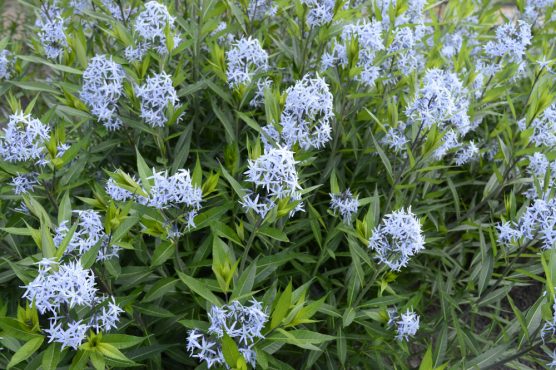
Blue Star ( Amsonia ) was awarded as the Perennial Plant of The Year in 2011. This plant is easily recognizable by its blue star-shaped petals. It has variegated green and yellow foliage that complements the flower incredibly.
The plant loves sunny areas but can also tolerate light to partial shade. Choose humus-rich soil with a lot of organic matter. During the summer season, water the plant frequently to prevent it from drying out ( also avoid sogginess ) and discontinue watering in fall.
12. Blue Violas
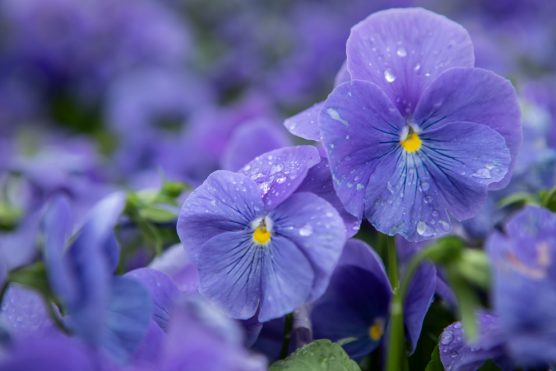
Violaceae or Blue Violas is not only an ornamental flower but you can also use it to garnish your delicacies and salads as it has edible flowers. You can find this flower in the market by a myriad of names like a garden pansy, sweet violet, Johnny-jump-up, etc.
Although it’s available in multi-colors including white, blue, yellow, deep violet, and cream. To grow this plant, choose rich, well-draining, and moist soil. Plant it under full sun and water it regularly with a tad discontinuation in between.
13. Bachelor Button Flower
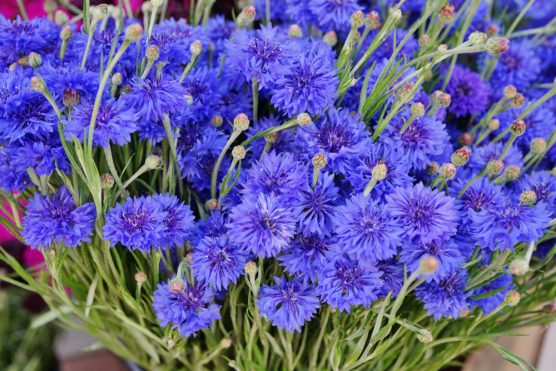
Bachelor Button flower ( Centaurea cyanus ) is also known as Cornflower, basket flower, and boutonniere flowers. It’s believed that during ancient times Bachelors used to wear this flower to impress their beloved and so it got the name.
Bachelor Button is the national flower of Poland but you can seamlessly grow it in your home garden. This flower is a low-maintenance and high yielding plant that doesn’t even require any fertilizer to grow well. Remember that if you’re using moist and or shady soil to grow this plant, it’ll be prone to insect infestation.
14. Siberian Squill
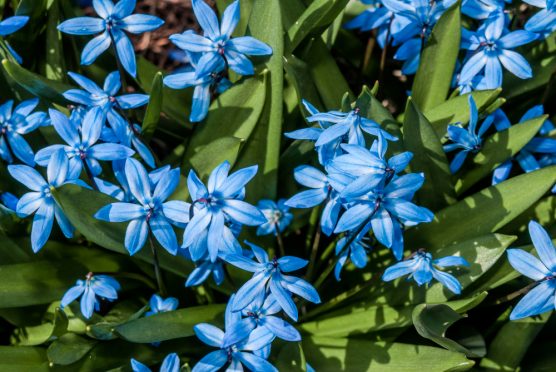
Ironically, Siberian Squill ( Scilla Siberica ) isn’t native to Siberia :-P. This plant multiplies at a whopping rate as it’s self-seeding and will profusely naturalize your home garden. The flower of this plant has a bell-shaped facade whereas the leaves look like green swords emerging out of the stem.
Siberian squills really love the sun and well-drained soil that is rich in organic matter. Plant it in a place where it can get afternoon shade too. Feed it with phosphorus-based fertilizer only when its foliage will start to emerge.
15. Blue Ribbons
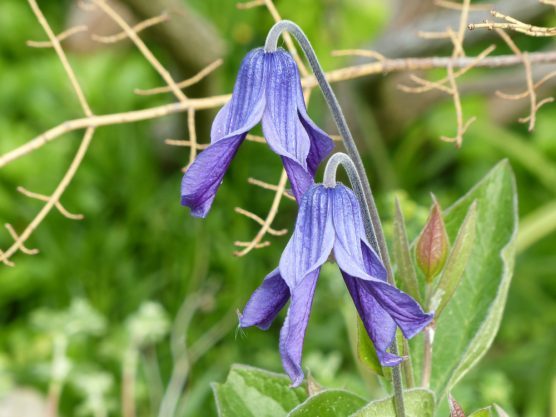
Iris X hollandica Or Dutch Iris ‘Blue Ribbon’ is a decadent plant with violet-blue petals and a yellow-colored pattern near the center. It has a dark green voluminous foliage which exceptionally suits the main flower. They make a great option for appealing bouquets.
Locate this plant in a sunny spot with well-drained soil and water it regularly especially during the blooming season ( i.e. mid-spring to late spring ).
16. Blue Calla Lilies
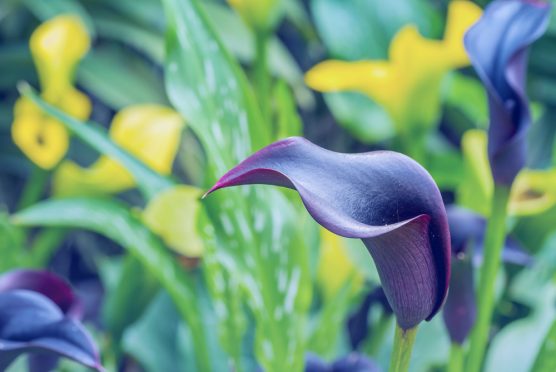
Blue Calla lilies aren’t exactly lilies but they have the same grace and superbness. This riveting flower is said to be associated with holiness, purity, faith, youth, and rebirth. The flower has a trumpet-like shape and is well-suited to deck up your boring garden.
These plants prefer warmer weather with well-drained, rich, and moist soil. Keep it under the sun with partial shade and you’ll witness the best growth. Apart from Blue, there’s a truckload of options to choose from, you can also try pink, white, yellow, and a lot more!
17. Sea Holly
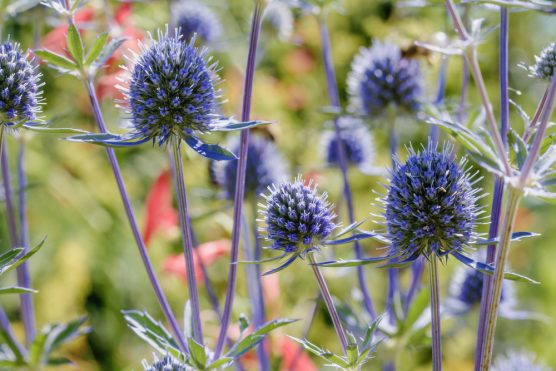
Sea Holly ( Eryngium ) could be a spectacular addition to your home garden. They have needle-like leaves supporting the clusters of teasle-like blooms. They have a green cone surrounded by blue, silver, or green colored petals. This flower is such a sight to behold.
This plant is drought-resistant and has a myriad of varieties to select from. All the varieties would grow well under the sun and well-draining moist soil. Best part? It can survive high negligence in terms of watering except in the prolonged drought conditions.
18. Agapanthus
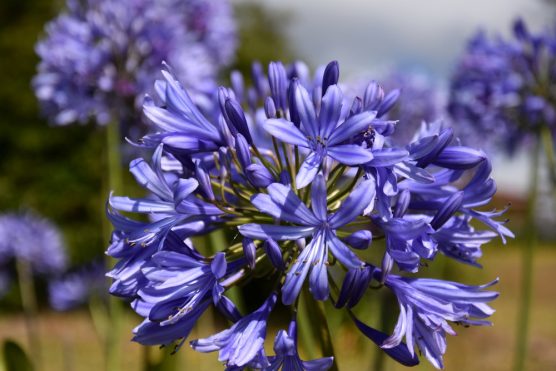
Agapanthus or Lily Of The Nile / African Lily is a disease-free and low-maintenance plant. You can pair it up with a white-colored flower to add a dramatic effect to your home garden. This gorgeous blue-violet flower is a perfect choice for an at-home bouquet.
These plants love a sunny location to thrive with a little shade. Regular watering and mulching would help your plant to grow well and healthy. Although they favor every soil type, a little addition of rich compost would suffice. Once established, it doesn’t require much overhaul and upkeep.
19. Blue Hydrangea
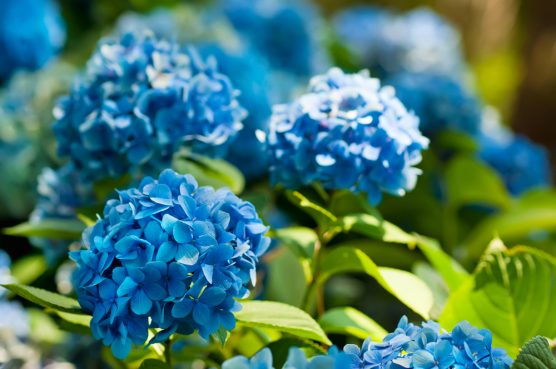
Do you know that the intensity of Blue Hydrangea ( Hydrangea macrophylla ) plants depends on the alkalinity of soil? So, if you’re on the lookout for an electric addition to your garden, the blue hydrangea is the best fit for you. You can effortlessly grow this plant in your garden to experience the grace of blue color.
The plant requires well-drained soil with a high amount of organic matter. The soil must be moist but not soggy or else the plant will rot. To further upgrade the soil quality, you can add compost to it before planting this beautiful friend.
20. ‘Love In A Mist’ flower
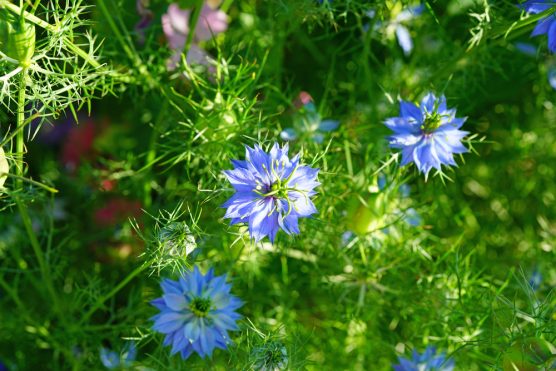
Love in a mist ( Nigella damascena ) is a mystical flower that will add a glorious effect to your home garden. The blue petals of the flower, sometimes, appear to be surrounded by mist and so is the name.
It’s a beginner-friendly flower and doesn’t require much gardening skills. The plant enjoys fertile soil and blooms in early spring. Water it regularly during the summer season and dry days and feed it an appropriate fertilizer now and then.
21. Allium
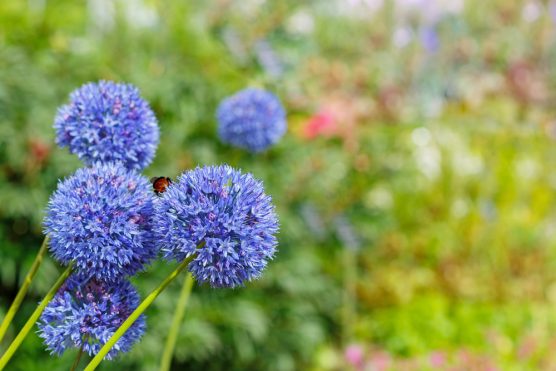
Alliums are multicolored plants that are available in blue, violet, pink, etc. in the market. The structure of Alliums includes a colorful furry ball at the top of a sleek and straight stem. This globe-like structure is the bloom which can be as huge as a soccer ball ( WOW! ).
Allium is a plant cousin of onions, garlic, chives, and shallots. Don’t worry, it won’t smell like them :-P. The water requirement of the plant is quite low and it requires full sun to grow. The type of soil required may vary species-wise.
22. Desert Bluebell
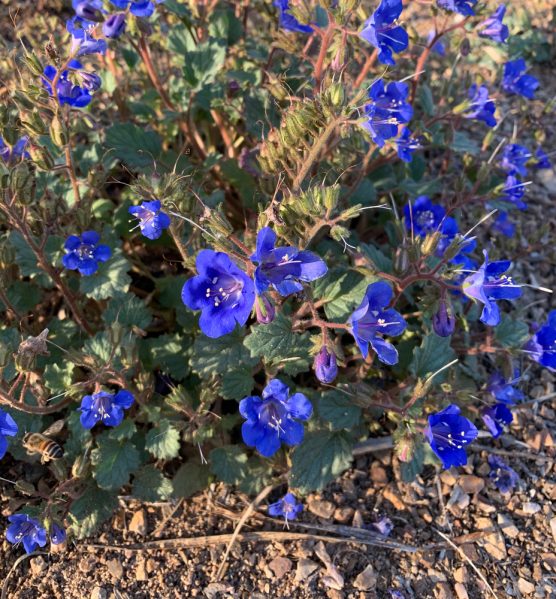
Desert Bluebell ( Phacelia campanularia ) has a deep and intensified blue-colored flower. The plant owes its name to the locality where you can find it. You can easily spot this plant in the Mohave Desert, California if you visit during the blooming season.
Although the plant naturally grows in the desert, you can sow it in your home garden as well. Don’t forget to check the hardiness of your residential location as the plant will grow only in the 9 or 10 hardiness zone. Plant it in a sunny location in well-draining sandy soil. Since the plant is fond of deserts, it requires minimal to no care at all!
23. Blue-fringed Daisy
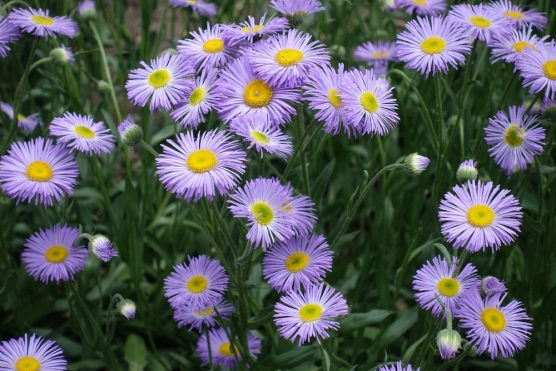
If you’re a fan of Daisies and willing to inculcate something blue into your home garden, Blue-fringed Daisy is the right option for you! The prettiness of Daisy combined with the elegance of blue color will put up a stupendous show upfront.
It has blue-colored petals surrounding a golden core. The plant prefers well-drained soil with an average amount of fertility in partial or full sun. This will bloom around midsummer.
24. Blue Impatiens
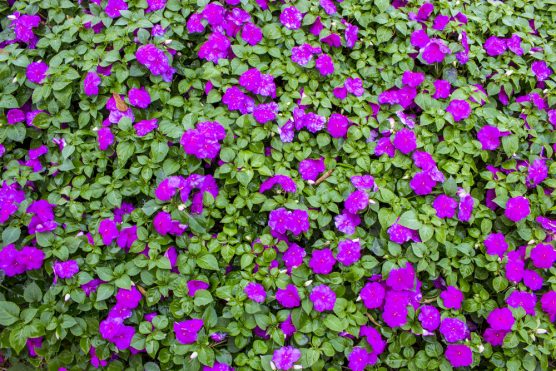
Impatiens arguta or blue impatiens is a violet-blue flower that symbolizes maternal love and affection. This flower was known as ‘Our Lady’s Earring’ during the medieval period. The plant is native to the Himalayas but that doesn’t mean you can’t enjoy it at your place. If you live in the US hardiness zone 7-11, it’s a win-win for you!
Spot a site with moist and fertile soil to grow this plant. Protect it from the afternoon sun, it can also tolerate shade for a long time. It’s a rare species of Impatiens, so you can buy them online instead of buying them from your local nursery.
25. Morning Glory
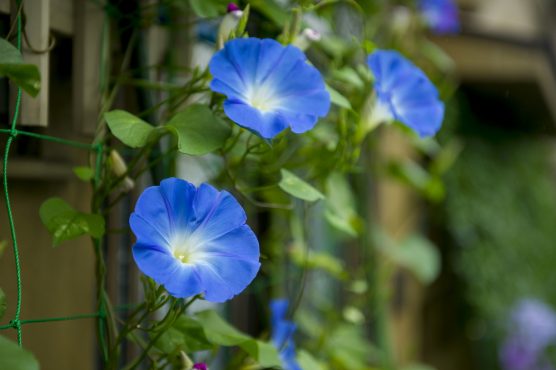
Morning Glory ( Ipomoea purpurea ) is probably the most commonly found blue flower in the world. There are innumerous species of morning glory which have everyone swooning over them.
The secret behind their immense popularity is their ease of growth. You can seamlessly grow morning glory in a container. The plant has a great tolerance to low-quality soil. Keep it under full sun with partial shade and in well-draining moist soil. Once established, water them twice a week during the dry season.
26. Anise-scented Sage
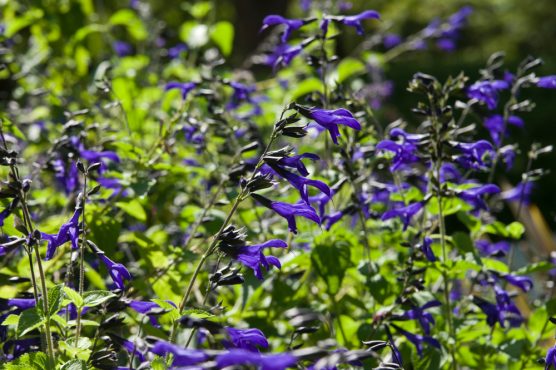
Salvia guaranitica or Anise-scented sage plant is a native to Brazil. This plant blossoms blue-colored flowers and is commonly known by several names like Brazilian sage, giant blue sage, sapphire sage, etc. These violet-blue flowers will invite a lot of birds, bees, and other pollinators to your garden.
The plant loves full sun with partial shade and will grow the best in fertile and well-drained soil. Water it frequently during the summer season but avoid overwatering.
27. Blue Orchids
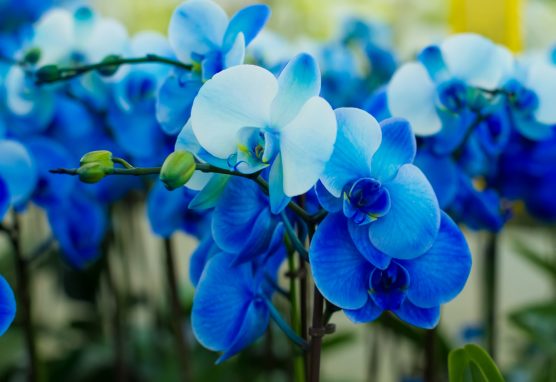
Orchids are truly a sight to behold and entirely indulge yourself into and here we’re talking about the majestic blue orchids. These rare and exotic flowers symbolize royalty and have a smooth way of capturing anyone’s attention and we don’t need a testament for it!
Although growing blue Orchids at home isn’t simple, nothing is unachievable if you’re passionate enough for it. First off, you’ll need a loose mixture of charcoal and bark as soil. Don’t overwater them as the soil may become soggy and cause the plant to die. Feed regularly with a fertilizer exclusively made for orchids to get the best view.
28. Blue Angel Salvia
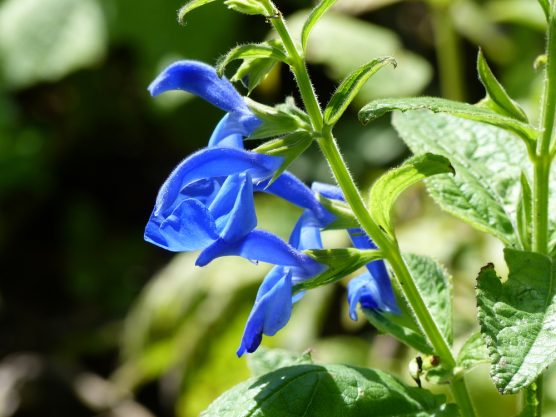
Include this astonishing blue-colored flower in your home garden and add all the missing charm in a go. This fragrant flower is a deciduous perennial that blooms around the summer and autumn season.
The plant will grow well in most soil types as long as the soil is well-draining and moist. Locate a sunny location with partial afternoon shade and water the plant averagely.
29. Blue Dandelion
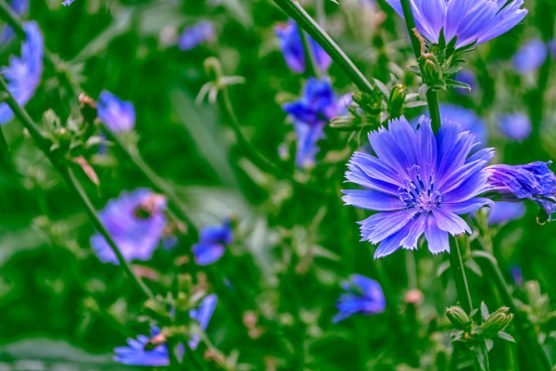
Blue Dandelion ( Cichorium intybus ) or Chicory is a bright blue-colored flowering plant that signifies culture. This flower is renowned in several folklores in ancient times. In recent years, people ate using it as a substitute for coffee and the plant is edible as a whole too.
Growing Chicory is fairly an effortless easy process. You can plant it in a container or directly in your garden. Choose a well-drained soil of any type and water it averagely avoiding soggy roots. That’s it, you’re set to enjoy this eye feast during the blooming season.
30. Siberian Larkspur
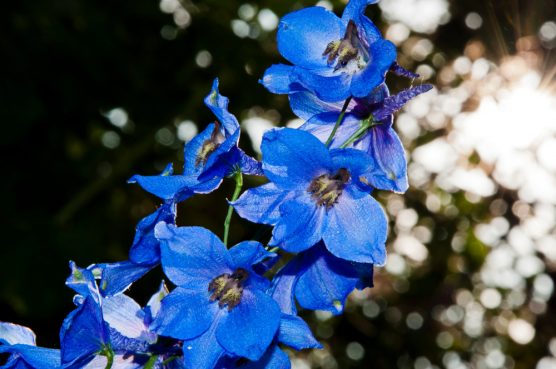
Siberian Larkspur or Delphinium grandiflorum is a dead-drop gorgeous blue-colored flowering plant. One notable thing about Siberian Larkspur is that this plant is toxic to touch and ingest, once established.
Provide this plant a sheltered spot where it could get at least six hours of sunlight with well-draining soil. Mix organic matter into the soil while planting for better growth. You’ll have to feed it with a balanced liquid fertilizer once in two weeks. Water it regularly during the summer season but avoid sogginess of the soil.
31. Anemone
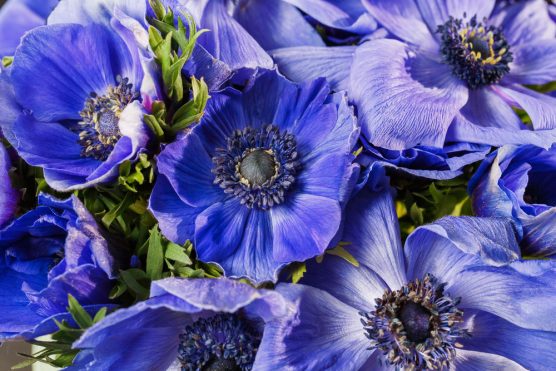
Anemone ( Anemonastrum ) or windflower is a simple yet gorgeous plant that’s available in a variety of bright-colored flowers. You can easily distinguish the appearance of this plant by a single flower standing on a green stem.
Plant anemones in a place where they’ll receive at least six hours of sunlight and the soil must be well-drained with an average amount of organic matter. Water it regularly in the dry seasons and don’t overwater at all.
32. Forget-me-not
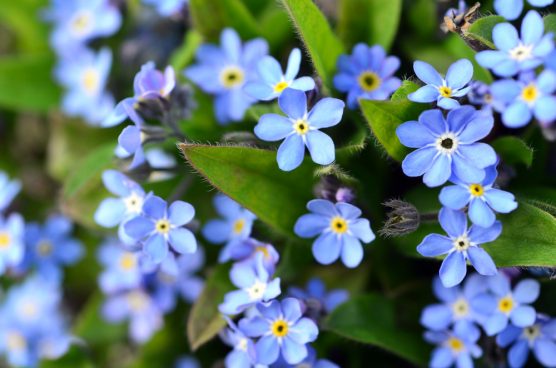 Fun fact: In the 15th century, the wearers of Forget-me-not were believed to be unforgettable by their lovers ( Pretty much explains the name 😛 ).
Fun fact: In the 15th century, the wearers of Forget-me-not were believed to be unforgettable by their lovers ( Pretty much explains the name 😛 ).
Forget-me-not ( Myosotis ) plants have charming blue-colored flowers on hairy green stems. This plant is truly unforgettable and desirable in your home garden. It doesn’t require much care and is a low-maintenance invasive plant.
They enjoy the full shade with partial sun. Fertilize the plant at most twice a season, the plant can easily grow in a dampened soil where most of the plants can’t survive. Find an appropriate place for this wildflower and enjoy the irresistible blooms.
33. Globe Thistle
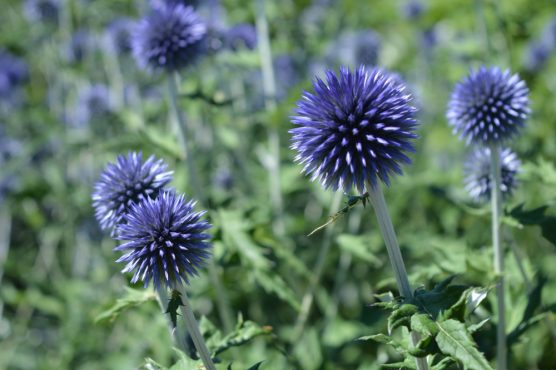
As the name suggests, Globe Thistles ( Echinops ) look like a globe standing on a green stick. The flower is a spiky globular structure with an eye-catchy appearance. Apart from the blue color, it’s available in purple and white as well.
These flowers would put an iconic show in a low-maintenance garden. Grow it in a place where it’ll receive maximum sunlight, the soil must be well-draining, dry, and rocky. Water it regularly while the plant is still young, it can survive drought conditions once established.
34. Blue Phlox
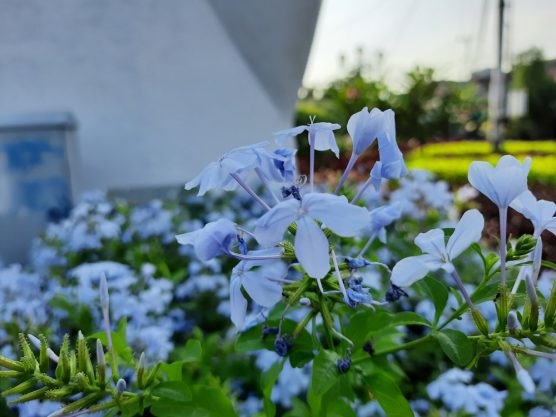
Blue Phlox ( Phlox divaricata ) is a simple flower with multiple cultivars that come in a variety of colors like light blue, rosy lavender, light purple, violet-blue, etc. It has a dashing and fragrant five-petaled flower that could be the poise to your garden.
Choose a well-drained, moist, and fertile soil to grow this plant. These plants thrive the best in the patched shade and would require fertilization around spring once a year.
35. Aster
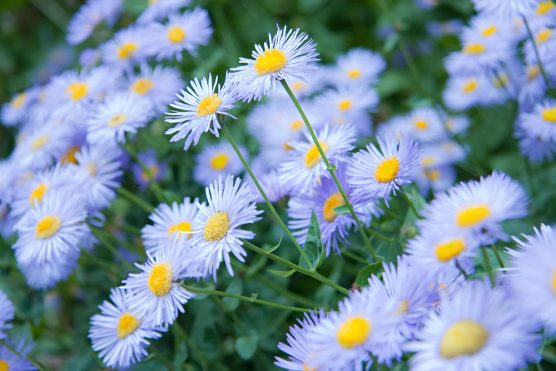
If you wish to add some liveliness to your autumn garden, Aster is the right fit for you. These purple-blue flowers are ravishing and will produce a worthwhile landscape on your patio. This plant is low-maintenance and highly rewarding.
Grow this plant in well-draining loamy soil under the full sun.
While watering, remember not to splash water on its foliage rather water the base to protect the shoots from fungal diseases. Supply balanced plant food to the growing Asters about once a month.
36. Iris
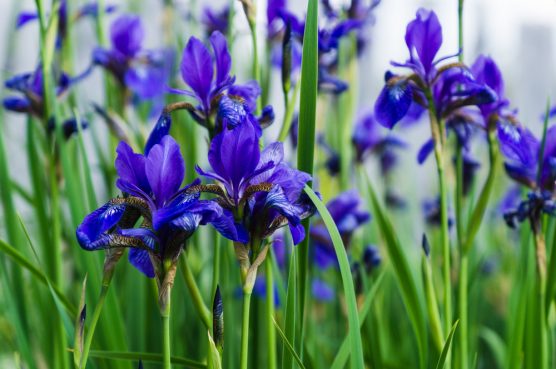
Irises are a common sight in most gardens, they provide incredible colorful blooms in sunny landscapes. Since the plant is toxic to touch, wear protective gloves while growing it. All the varieties of Iris are low-maintenance and tolerant of negligence.
Locate a spot with well-draining rich soil and where the plant would receive at least 5 hours of sunlight. Feed the soil with a low-nitrogen fertilizer one month before the blooming season. You’ll have to be diligent about watering during the dry months.
37. Periwinkle
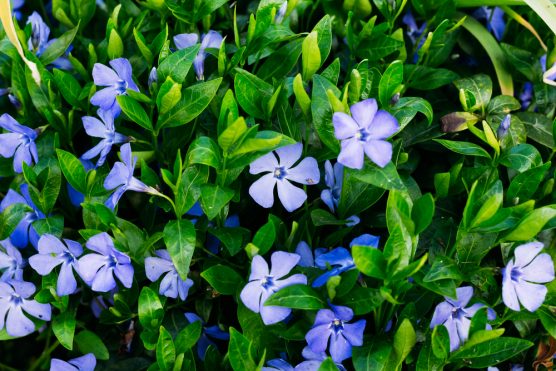
Vinca or Periwinkle is an uncomplicated creeper plant with violet-blue blooms. It’s also referred to as the creeping myrtle or creeping vinca. Periwinkle can grow effectively in a variety of soil conditions and sunlight, however, they grow best in acidic soil in partial shade.
It’s prolific to grow Periwinkle in the areas that are prone to soil-erosion as it firmly holds the soil. Don’t misunderstand the ground cover Periwinkle plant with annual Periwinkle as they both might sound similar but have distinguishable properties.
38. Blue Carnation
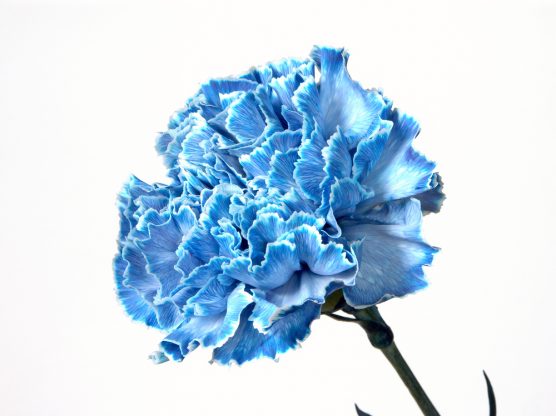
Blue carnation ( Dianthus caryophyllus ) is an intricate and desirable plant that doesn’t grow anywhere naturally. However, scientists have worked out a way to cultivate them after years of researching ( thankfully! ). Blue carnations are downright mesmerizing and would make a great choice for bouquets.
You may start the carnation plants six to eight weeks before growing them outdoors. They won’t survive in frosty weather as these sun-loving flowers require at least 5 hours of sunlight every day. Water it once a week and feed them with a 20-10-20 fertilizer. Stay cautious while planting these flowers as they require extra care and preparations.
39. Gentian Sage
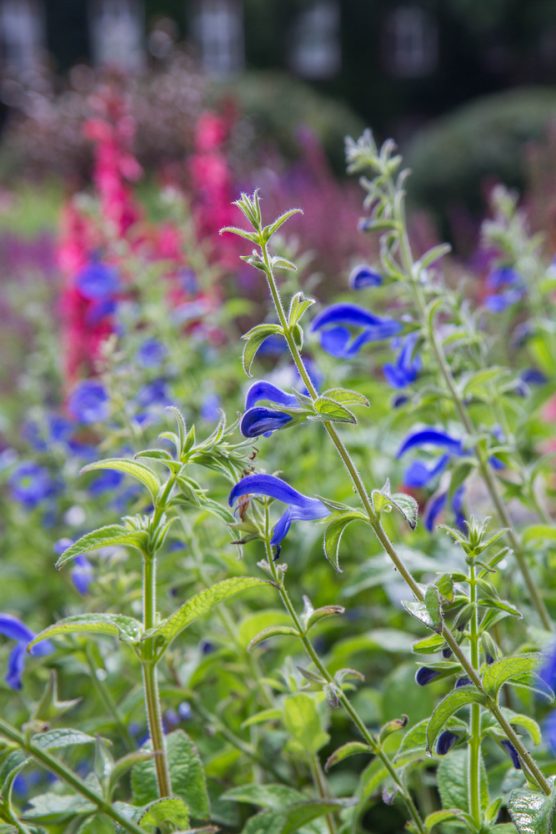
Salvia patens or Gentian Sage is an exotic plant species that you can enjoy in your garden. These plants are one of the deepest and brightest blue-colored plants in the world. The plant is not only showy but will also safeguard your garden from the deers. It has evergreen foliage that is highly welcoming to the flies and birds.
To plant this riveting flower in your garden, select a spot with a loamy, chalky, or sandy texture. The drainage system of the soil must be well-built and moderately fertile. The plant thrives best under full sun and an average amount of watering is required.
40. Georgia Blue
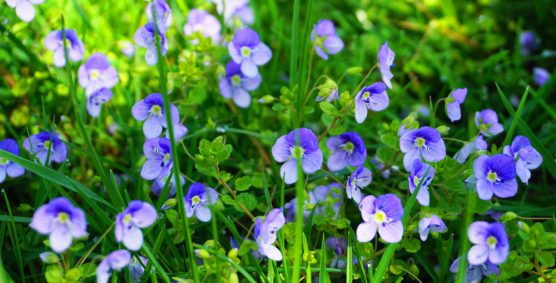
Georgia blue ( Veronica peduncularis ) is another plant with small sapphire-blue flowers studded all over the foliage. You must’ve commonly heard about it by the name ‘Speedwell’. These undemanding perennials bloom from late spring to autumn. It’s a low-maintenance plant that can tolerate a variety of soil as long as it’s well-draining.
Provide it with full sun to partial shade and maintain the medium moisture content in the soil and surroundings. One remarkable thing about their foliage is that it turns bronzy-purple in winters and purple in summers.
41. Clematis
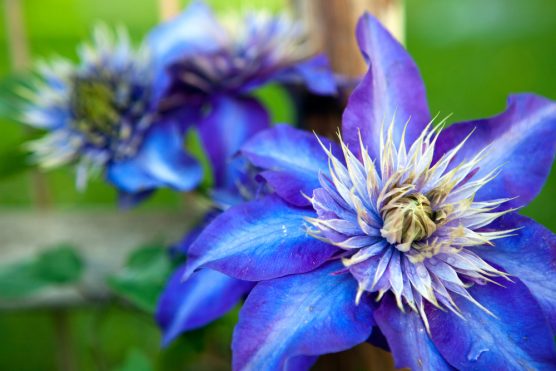 Presenting you with an ornamental climber that is present in a multitude of varieties in the market. This plant is widely known as the ‘Queen of Climbers’ and is profusely popular among gardeners these days. The plant has purple-blue bloom growing through deep-green foliage.
Presenting you with an ornamental climber that is present in a multitude of varieties in the market. This plant is widely known as the ‘Queen of Climbers’ and is profusely popular among gardeners these days. The plant has purple-blue bloom growing through deep-green foliage.
Some cultivars of the Clematis prefer a sunny spot while the others bloom in partial shade. Ideally, Clematis requires at least five to six hours of sunlight a day and well-drained moist soil with a slightly alkaline pH value. Dig in a fair amount of fertilizer and compost while planting and you might have to feed it with water-soluble organic fertilizer again in the growing season.
42. Himalayan Blue Poppy
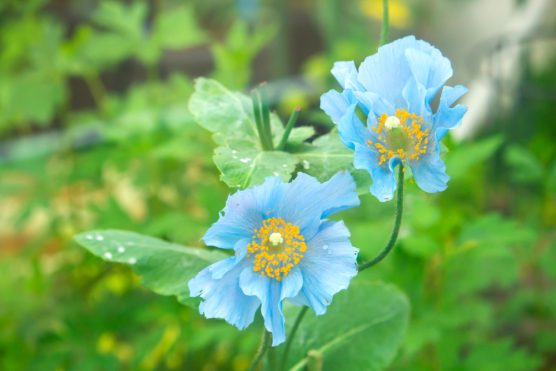 If you’re willing to enjoy these exclusive and engrossing blue-colored flowers, roll up your sleeves and brace yourself to roll into the soil. Meconopsis betonicifolia or blue Himalayan Poppy, as you call it, is the national flower of Bhutan but folks around the world are going gaga over these spellbound blooms.
If you’re willing to enjoy these exclusive and engrossing blue-colored flowers, roll up your sleeves and brace yourself to roll into the soil. Meconopsis betonicifolia or blue Himalayan Poppy, as you call it, is the national flower of Bhutan but folks around the world are going gaga over these spellbound blooms.
To grow Himalayan blue poppy in your garden, you strictly need optimum soil and weather conditions. Find an area with well-draining rich soil and a partially shady spot. Avoid over-watering and feed the soil with ample organic matter before planting. Remember, it’s everything or nothing in this case.
43. ‘Cambridge Blue’ Lobelia
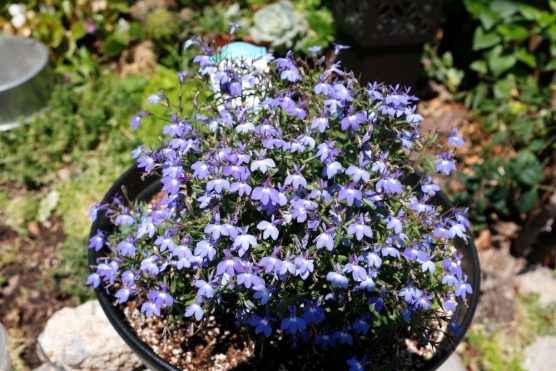
‘Cambridge Blue’ Lobelia ( Lobelia erinus ) is a voluminous plant with a heavy bloom that also hides most of its foliage. The flowers are of fine blue color with light green foliage. It’s easy-peasy to grow and even easier to take care of.
Its vibrant colors will attract useful birds and flies to your home garden. Besides, they’re feasible to be grown in the containers as well. These flowers like cool springs and shaded summers in a moist, rich, and well-draining soil.
44. Blue Crown Passion Flower
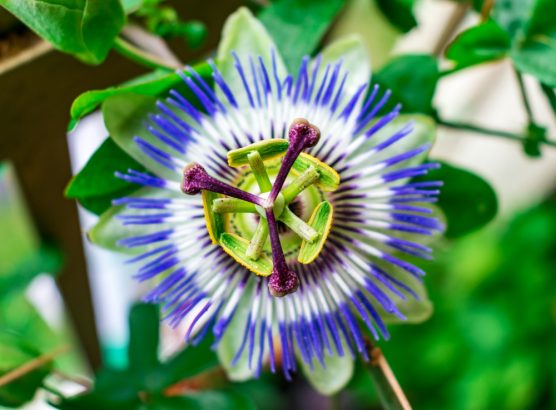
Passiflora caerulea or Blue crown passionflower is a breathtaking vine that is fairly resistant to cold conditions and blooms all summer. This exotic flower has petals of off-white color and a crown-like structure of blue, white, and purple filament.
Surprisingly, it’s easy to grow under full sun or partial shade. The soil must be loose, sandy, moist, and well-drained. Since the plant is a creeper, you might have to install a trellis for its optimal growth.
45. Blue Wild Indigo
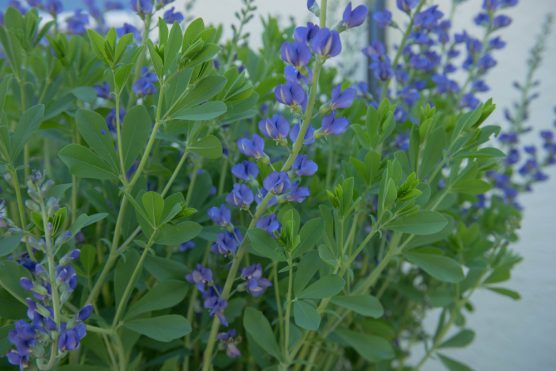
Baptisia Australis or Blue Wild Indigo, also widely known as False Indigo, needs no introduction. This American beauty will add the perfect amount of blue to your home garden. The plant is quite adaptable but certain conditions can do wonders to its growth.
Blue Wild Indigo prefers at least six hours of sunlight daily and the soil must be drier and well-draining. The plant blooms from late spring to early summer and requires watering during the initial growth stages. It becomes drought-tolerant once established successfully.
46. Glory-of-the-snow
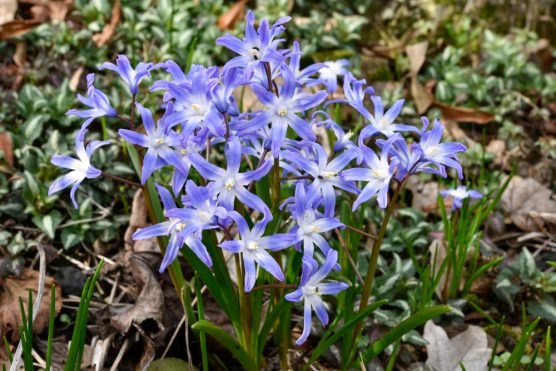
Scilla Section Chionodoxa, commonly known as glory-of-the-snow, is an invasive perennial which is one of the first flowers to bloom in spring. They roughly start flowering even before the snow entirely melts and so is the name.
Choose a location where it would receive full sun with partial shade. Like other plants, this plant also requires well-drained soil with compost. Fertilize it in early spring and water only if the spring season is dry.
47. Harvestbells
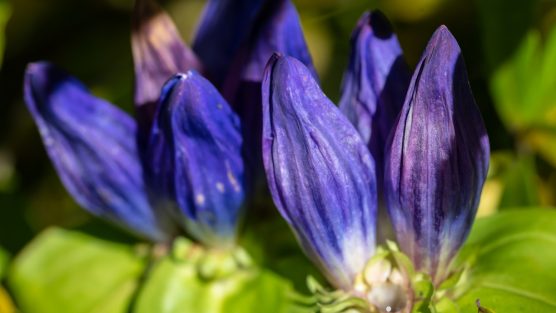
Harvestbells ( Gentiana saponaria ), often known as Soapwort Gentian is a blue-violet flower bearing a close resemblance to bottles. These flowers don’t have a significant opening, so they appear to remain closed. They have got a prominent role in attracting bumblebees to your home garden.
Their peculiar shape makes them highly desirable and valuable for any garden. They enjoy fertile and sandy soil with a partially shady spot. With a tad bit of maintenance and upkeep, you can rejoice this quirky creature for a long time.
48. Blue Hibiscus Flower
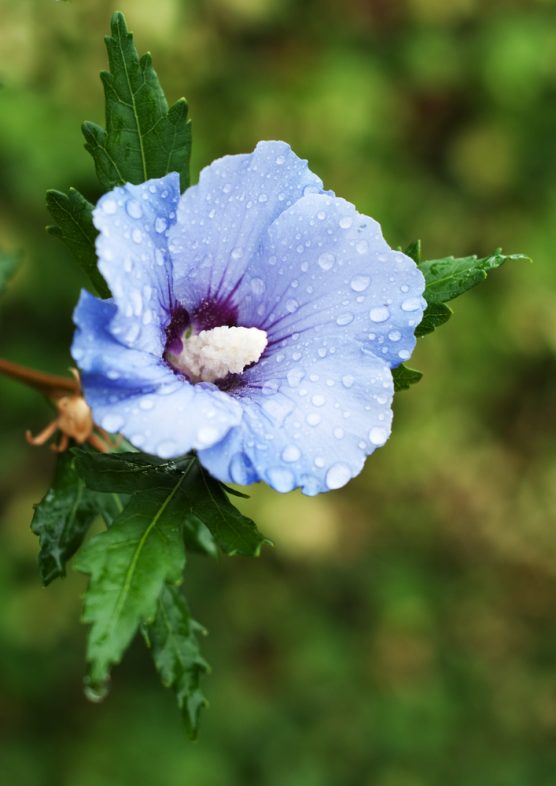 Needless to mention that the Blue Hibiscus flower ( Alyogyne huegelii ) is a rare and exotic cultivar of the Hibiscus family. With that, it could be an incredible addition to your dream garden. Since no living flower is truly blue, these blue hibiscuses are rather violet-blue. But the color has the same frontage as blue.
Needless to mention that the Blue Hibiscus flower ( Alyogyne huegelii ) is a rare and exotic cultivar of the Hibiscus family. With that, it could be an incredible addition to your dream garden. Since no living flower is truly blue, these blue hibiscuses are rather violet-blue. But the color has the same frontage as blue.
This plant prefers slightly alkaline soil with no need for additional supplements ever after. The shrub requires mulching to provide ambient conditions for the roots. Water it regularly and witness the wonder!
49. Stiff Blue-eyed Grass
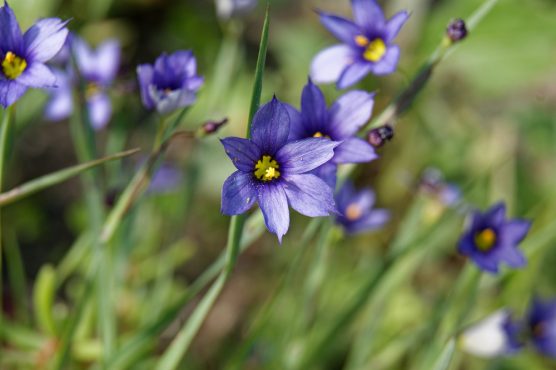
Ironically, Stiff blue-eyed grass ( Sisyrinchium ) is a magnificent violet-blue flowering plant. This plant will work in almost any garden and will attract birds and flies to your home garden.
Select a spot where the plant would receive low light with well-draining soil texture. Though the plant will work under the full sun as well. Mulching is necessary to fulfill its nutritional requirements and protect it from freezing temperatures.
50. Poor Man’s Weatherglass
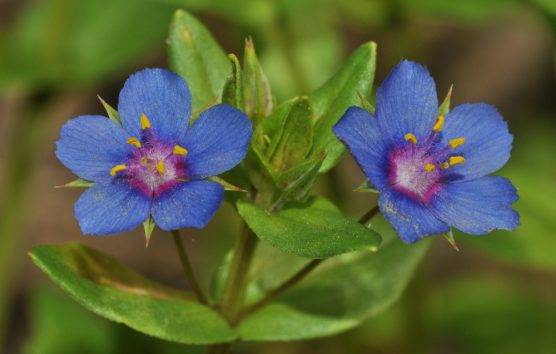
It’s believed that in ancient times, people used this plant to predict weather according to its blooming time. Poor man’s weatherglass ( Anagallis arvensis ) is available in tons of colors but the blue one is unparalleled. Besides, it’s also known as Blue Pimpernel, Shepherd’s Weatherglass, and so on.
To grow this plant in your garden, choose sandy and well-draining soil with an average amount of watering. The plant must receive full sun to partial sun to grow the best. Feed it with a general-purpose fertilizer every six weeks and you’re good to go!
51. Butterfly Pea
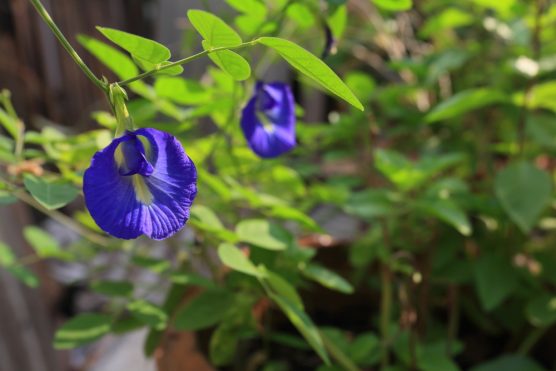 Clitoria Ternatea, commonly known as Butterfly Pea, is an attractive and useful perennial herb. It’s a wildflower that occurs in dry and rocky regions, and it’s quite uncommon in the Southwest US. People harvest this plant for food, medical, and adornment purposes. People utilize it in the medical field for treating eye problems, snakebites, and so on.
Clitoria Ternatea, commonly known as Butterfly Pea, is an attractive and useful perennial herb. It’s a wildflower that occurs in dry and rocky regions, and it’s quite uncommon in the Southwest US. People harvest this plant for food, medical, and adornment purposes. People utilize it in the medical field for treating eye problems, snakebites, and so on.
Although the plant is native to southeast Asia, you can easily find it in the US too ( thanks to globalization! ). It prefers partially shaded regions with cool but frost-free conditions. The soil must be well-drained and rich in organic matter. Water it regularly to avoid any failure in growth.
52. Bellflower
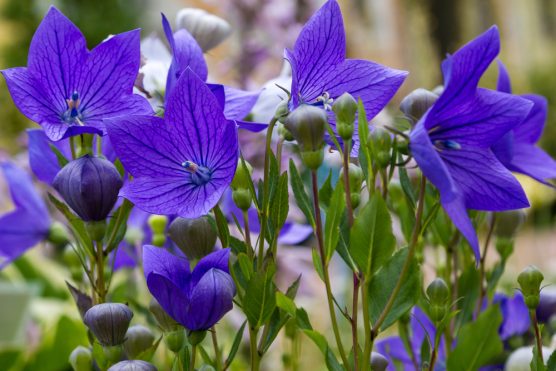
Bellflowers ( Campanula ) get their name from the bell-shaped bloom. This cheerful plant is a must-have for your blue theme garden. It carries a distributed combination of light blue and violet shades with yellow-green foliage.
These plants could tolerate high levels of acidity in the soil and long periods of drought when established. Initially, they require moderately moist well-draining soil under full sun and regular watering.
53. Blue Petunias
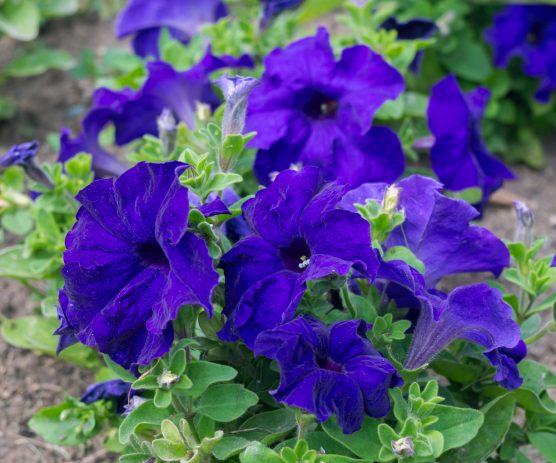
Petunias ( Petunia × atkinsiana ) need no introduction as they’re one of the most commonly found green friends in the American home gardens. From borders to beds to baskets, they fulfill every purpose.
Petunias are available in almost all colors but our today’s star is a Blue Petunia. But wait, aren’t there tons of varieties in Blue Petunias? Yeah, you got it right!
Well, there are some common growing conditions for every Petunia. Pick a spot with well-drained soil and plant them where they’ll receive full sunlight for most of the day. The water requirement is moderate – neither too high nor too low.
54. Blue Fan Flower
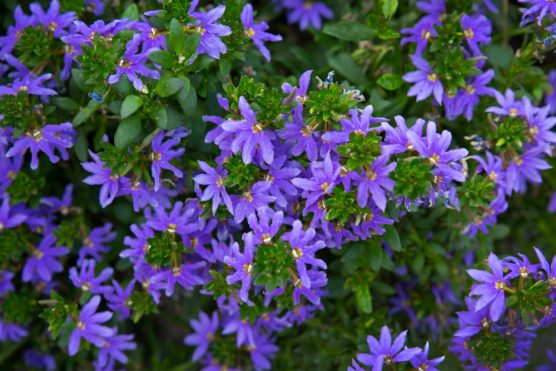 Blue fan flower ( Scaevola aemula ) is an uncomplicated violet-blue bloom that follows hassle-free procedures for their upkeep and overhaul. Alongside being a legit garden plant, the Blue Fan flower is also a great container or basket plant.
Blue fan flower ( Scaevola aemula ) is an uncomplicated violet-blue bloom that follows hassle-free procedures for their upkeep and overhaul. Alongside being a legit garden plant, the Blue Fan flower is also a great container or basket plant.
Select loose and sandy soil with appropriate amounts of organic matter and compost in it ( you might as well need to mix some ). Water them regularly and keep them under full sun to help them receive at least eight hours of sunlight a day.
55. Balloon Flower
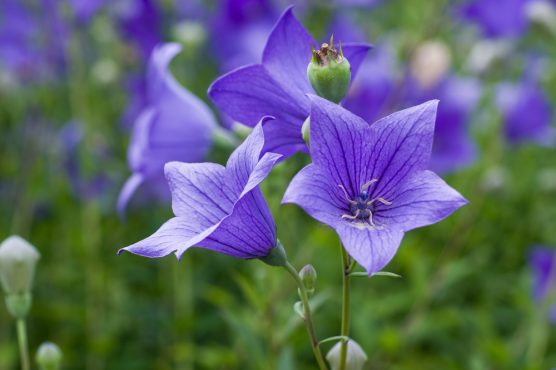
Balloon Flowers ( Platycodon grandiflorus ) are a part of the Bellflower family that we’ve mentioned above. Like them, Balloon flowers are also low-maintenance and fun to grow. They have a blue-violet shade on their flowers and are native to Japan, China, Korea, and Russia.
These plants are sun-loving, i.e., require at least 6 hours of sunlight, except for hotter days. On hotter days, you might need to keep the plants under partial shade. These flowers prefer organically rich and well-drained soil with consistent watering to younger plants. Avoid the soil from getting soggy.
56. Swan River Daisies
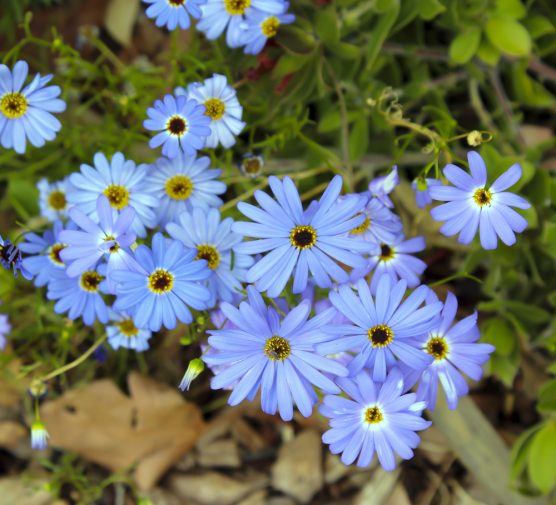
Brachyscome iberidifolia or Swan River Daisy is an easy-going and seamless-to-grow plant. This plant is available in a multifold of shades contributing largely to its popularity. Ironically, the plant doesn’t grow in the rivers but on land. The flower’s color ranges from blue to lavender, pink, and even white.
These plants prefer at least six hours of direct sunlight a day and rich, moist, and well-draining soil. Without these conditions, your bloom might suffer in terms of quality and quantity. Water majorly during the long stretches of dry seasons only.
Whether or not mother nature gives birth to any blue flower, these closely related similar shades are equally mystique and dynamic to behold. Go ahead and put on your gardening shoes to build a worthwhile landscape for yourself ;).

